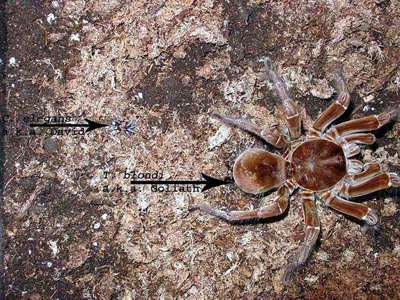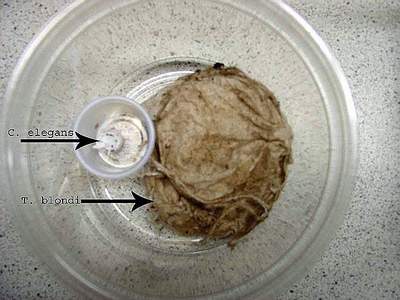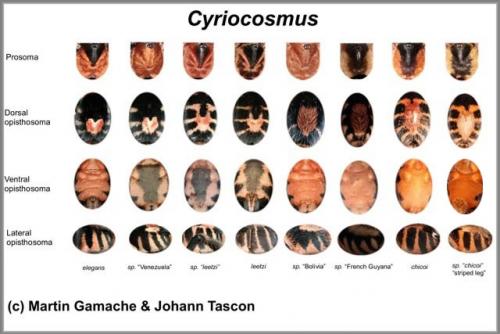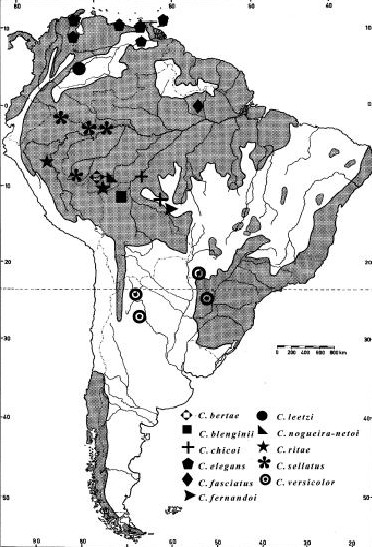Cyriocosmus
Genus Cyriocosmus Simon, 1903*
Genus status. Synonymized genus Pseudhomoeomma Mello-Leitao, 1930 (by Gerschman&Schiapelli, 1973) and Erythropoicila Fischel, 1927 (by Raven, 1985).
Several species found and established in hobby recently still undescribed.
Type species – Hapalopus sellatus Simon, 1889.
The difference of the genus Cyriocosmus in whole from all other Theraphosinae subfamilies, consists of the following diagnosis: the male can be distinguished from all other theraphosids, except some Hapalopus species, by the presence of a paraembolic apophysis on male palpal bulb (in two species - C. perezmilesi and C. blenginii this character is reduced). Male Cyriocosmus can be distinguished from Hapalopus by the divergent branches on the tibial apophysis. The female can be distinguished from all other theraphosid species by having a sinuous or spiral spermathecae neck with a convex base. The only presented modified type III urticating hairs having short barbs along more than half of its length.
The follwoing key to the species are established (Kaderka **(2007) after Fukushima et al. (2005). Two newly described species from Peru not included):
| By females (female of Cyriocosmus bertae is unknown) | By males |
| 1. Striped pattern on dorsal surface of abdomen.
- present ………………….…....................……. 2 - absent, dark cephalic area present …....…… ................................................Cyriocosmus versicolor
2. Cephalic area: - the same colour as the carapace .......................... .………..............….……..……......… Cyriocosmus perezmilesi
- darker than the carapace ………...................... 3 3. Dorsal abdomen with three clear stripes on each side ........................................…........… Cyriocosmus leetzi
- more than three stripes …….……….……..….. 4 4. Clear central patch covering approximately 80% of the dorsal abdomen................... Cyriocosmus fasciatus
- Clear central patch covering approximately 30% of the dorsal abdomen.…................ Cyriocosmus elegans |
1. Striped pattern on dorsal surface of abdomen: - present ……………………………..…………. 2 - absent …………………..……………..……… 5 2. Cephalic area: - the same colour as the carapace ........................... ………….………..….......…........ Cyriocosmus perezmilesi
- darker than the carapace ..…………........... 3 3. Dorsal abdomen: - with three clear stripes on each side; weakly developed PS keel …….................…....…….… Cyriocosmus leetzi
- more than three stripes; well developed PS keel ……………..…………………................................... 4 4. Clear central patch covering approximately 80% of the dorsal abdomen................... Cyriocosmus fasciatus
- clear central patch covering approximately 30% of the dorsal abdomen..................... Cyriocosmus elegans
5. Dark cephalic area present ... Cyriocosmus versicolor
- cephalic area the same colour as the carapace..... ………….……................................. Cyriocosmus bertae |
 The genus Cyriocosmus was first described in 1903 by Eugene Simon and included Hapalopus sellatus Simon, 1889, as type species, and Hapalopus elegans Simon, 1889. The genus was established based on the presence of a bifid apophysis on the palpal bulb, unique in Theraphosidae.
The genus Cyriocosmus was first described in 1903 by Eugene Simon and included Hapalopus sellatus Simon, 1889, as type species, and Hapalopus elegans Simon, 1889. The genus was established based on the presence of a bifid apophysis on the palpal bulb, unique in Theraphosidae.
In 1939, Mello-Leitao described two species: C. nigriventris from Venezuela and C. semifasciatus from Trinidad, West Indies.
Schiapelli & Gerschman de Pikelin (1973) revised the genus, but did not examine the types of C. nigriventris or C. semifasciatus. They synonymised C. semifasciatus with C. elegans and transferred the species Cyclosternum versicolor Simon, 1897 to Cyriocosmus. The authors also established the synonymies of the genus Pseudohomoeomma Mello-Leitao, 1930 with Cyriocosmus Simon, 1903, and the type species, Pseudohomoeomma fasciatum, described for Brazil, with C. elegans.
 Raven (1985) synonymised the genus Erythropoicila Fischel, 1927, with its single species E. plana, with Cyriocosmus, resulting in the new combination C. planus.
Raven (1985) synonymised the genus Erythropoicila Fischel, 1927, with its single species E. plana, with Cyriocosmus, resulting in the new combination C. planus.
In 1998, Perez-Miles revised the genus Cyriocosmus, describing four more species from Brazil (C. chicoi, C. bertae, C. ritae and C. butantan) and one from Bolivia (C. blenginii). Perez-Miles also transferred C. nigriventris to Metriopelma and synonymised C. planus with C. elegans.
In 2005 in their work Fukushima et al. (2005)* the genus Cyriocosmus was keyed and a cladistic analysis was undertaken for all known species (see: Systematic news).
One of the undescribed species known as "Cyriocosmus sp. Bolivia" is the biggest known representative of the genus can reaches near 5 cm of body length just recently was described in October 2007 by Czech arachnologist Radan Kaderka (see below).
In 2009 PÉREZ-MILES, F. and D. WEINMANN had described two new species from Peru mountains range (known as the highest altitude distributed species of theraphosid spiders - nearly 3000 m above see level).
The genus is presented by 14 described species of one of the smallest tarantulas of the World, wich the biggest represebtatives reaching 5 cm, but most are just 2-3 cm in the size of a body. Known mature males of species are appreciably much smaller than females (adult males of C. elegans can reach just a few mm in LS over 1 cm) and do not differ from them in coloration.
Probably, a new species would be found out and described in the near future again.
Similarly to species of genus Cyclosternum the majority of Cyriocosmus spp. have characteristic striped patterns on abdomen and the general bright overall coloration of a body.

In nature they live in burrows and also use others natural ground shelters. Concerning the species C. ritae there is an information on conducting a vagrant (nomadic) style of life (does not occupy a constant burrow during life).
There are also some interesting facts about the life history of these tarantulas. In recently published article in German Wolfgang Altmann has describe the evidence by the author of very dence population found in Tabago Island - over the 100 tarantulas of the different ages of the species Cyriocosmus elegans cohabiting on the 1 square meter area.
Another one fascinating evidence is illustrated by Czech arachnologist Radan Kaderka, who was observed in situ the species Cyriocosmus perezmilesi leading semi-atrboreal style of life in the hollows of the trees in Bolivia, San Buenaventura, Beni Province, cohabiting with the Labidognatha spider (see - ).
 Duration time to maturity is surprisingly shot - both males and females become mature approximately at the same time - 10 to 12 months.
Duration time to maturity is surprisingly shot - both males and females become mature approximately at the same time - 10 to 12 months.
This together with some other data will give an approach that these incredible nice tarantulas unfortunately do not live very long. The expected lifespan of these dwarf jewels is around 5-7 years.
Keeping conditions. Rather seldom seen in collections among tarantula keepers of the world (only C. elegans, C. perezmilesi and C. leetzi are known). Cases of breeding in captivity are individual and most spiderlings produced in a care of several remarkable hobbiests (Ray Gabriel (UK) Martin Gamache (CA), Eric Reynolds (USA) after that they start to much widely presented in collections.
The offspings are so tiny and small in size that it is hard to find them in the substratum and one can be completely lost in the big container. But they're grow rather rapidly and had a very good appetite, doubling the size after every molt.
They must be kept in small terrariums on a layer of the slightly humidified substratum of 5-6 cm layer, with retreat and a water bowl are required. Also they like to dig burrows in substratum.
Not aggressive, but enough nervous tarantulas conducting secretive way of life. Demand average humidity about 60-70 % and temperatures 26-28°С.
The imitation of "dry season" with increased temperature and humidity after it is cause a breeding activity and producing the eggsac. Not any sign of aggression from female during mating are noted.
The eggsac can consist surprisingly a large number of eggs - to 100, but usually 50-70. The incubation period of cocoon (first stage spiderling emerge) is about a month.
Distribution. The species of genus Cyriocosmus are inhabits exclusively on south-american continent and occupy mainly a zone of rain forests. The only exceptions are C. leetzi, C. fernandoi and in part C. versicolor (see map).
Do not meet only in the southern and also the eastern territories of South America.
|
Species |
Common name |
Areal |
Photo |
Biology, status |
Keeping conditions |
|
bertae |
- |
Brazil (Rio Branco, state of Acre) |
|
Any biology data is unknown. |
Keeping requirements and information is absent |
|
blenginii |
- |
Bolivia (Mamore River) |
- |
Any biology data is unknown. |
Keeping requirements and information is absent |
|
chicoi |
- |
Brazil (state of Rondonia) |
|
Any biology data is unknown |
Keeping requirements and information is absent |
|
elegans |
- |
Venezuela; Trinidad and Tobago Island, West Indies |
Photo Barry Wiles © 2004
Photo Guy Tansley © 2005 |
Seldom seen in the hobby |
Can be kept similiar as and became more often in captivity last time |
|
fasciatus |
- |
Brazil (Cumina River, Para) |
Revalidated by Fukushima et al., 2005 form C. elegans |
Can be kept similiar as |
|
|
fernandoi sp.n. |
- |
Brazil (Mato Grosso) |
Photo R. Bertani © 2005* |
Newly described species. |
Keeping requirements and information is absent |
|
leetzi |
Colombian dwarf tarantula (not official) |
Colombia |
Photo Guy Tansley © 2005 Photo Timo Raab © 2005 |
Reaches 2 cm in body length. |
Can be kept in conditions as it has already describe above relating the genus in general |
|
nogueira-netoi sp n. |
- |
Brazil (Rio Branco, state of Acre) |
Photo R. Bertani © 2005* |
Newly described species. The name is a patronym in honor of brazilian researcher Dr. Paulo Nogueira-Neto. |
Keeping requirements and information is absent |
|
perezmilesi |
- |
Bolivia (Beni prov.) |
|
Named in honour of Dr. Fernando Pérez-Miles, a Uruguayan arachnologist. Known as possibly the bigest representative of the genus, reaches to 5 cm in BL |
Can be kept in conditions as it has already describe above relating the genus in general |
|
pribiki |
- |
Peru |
- |
- |
Yet is unknown in captivity |
|
ritae |
- |
Peru (Colonia); Brazil (state of Acre) |
|
Female is unknown. |
Keeping requirements and information is unknown |
|
rogerioi |
- |
Peru |
- |
- |
- |
|
sellatus |
- |
Brazil (states of Amazonas and Acre); Peru |
|
Any biology data is unknown |
Keeping requirements and information is absent |
|
versicolor |
- |
Argentina, Paraguay |
- |
Any biology data is unknown |
Keeping requirements and information is absent |
*By: Caroline Sayuri Fukushima, Rogerio Bertani & Pedro Ismael Da Silva Jr. "Revision of Cyriocosmus Simon, 1903, with notes on the genus Hapalopus Ausserer, 1875 (Araneae: Theraphosidae)"
**Kaderka, Radan (2007) Cyriocosmus perezmilesi sp. n. from Bolivia (Araneae: Theraphosidae: Theraphosinae). Revista Ibérica de Aracnología, Vol. 14






